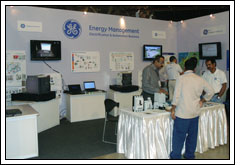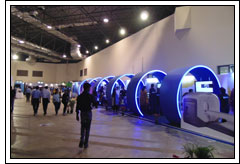
Wind turbines made especially for low-wind regimes in India was just one of the several innovations showcased at the recently-held “Techmela,” at Bengaluru’s KTPO Exhibition Centre. Dubbed as “GE’s Carnival of Innovation,” the technology fair had on display the finest technology of GE across all its divisions – healthcare, transportation, aviation, power & water, oil & gas and energy management. The event was a collective manifestation of innovative pursuits of the 5,300-plus scientists at GE India Technology Centre. Covering a sprawling campus of 50 acres, the GE ITC, officially John F. Welch Technology Centre (JFWTC), is GE’s largest integrated multidisciplinary R&D centre in the world, outside US. Since its establishment in 2000, GE has so filed over 2,000 patents from JFWTC alone.
Discussing the low-wind regime turbines with the media, GE engineers said that the 1.6-mw turbines have been in commercial operation since 2010. The turbines are manufactured at GE’s plant in Pune. These turbines with a mast height of 80m have blades covering a very large area for greater efficiency, making them ideally suited for low-wind regimes. GE engineers were quick to note that the company produced a wide range of turbines for various applications. “We have turbines using a variety of technologies – geared and even direct-drive, for both onshore and offshore applications,” a senior GE scientist explained, adding that turbines with higher-than 1.6 mw were under development. GE was committed to recommending the best technology to wind power producers, depending on the site conditions, he noted. Apart from wind energy, GE also offers innovative technology to the solar power sector cover both photovoltaic and concentrated solar power (CSP) plants.

In the conventional power space, GE engineers shed light on the various solutions for gas-based power plants. GE provides solutions to small power plants (up to 10 mw) through reciprocating engines. “There is high demand for such engines from the industrial sector in gas-rich Bangladesh,” a GE engineer said. For plants between 10 mw and 70 mw, GE uses “aerodynamic” technology while for the utility sector (between 70 mw and 35o mw), GE has successfully developed the Frame 7FA and Frame 9FA architecture. It may be recalled that in late 2010, GE had won $750-million worth of orders from Reliance Power to supply six Frame 9FA turbines for its 2,400-mw Samalkot project in Andhra Pradesh. The orders also covered three D-11 steam turbines, training and long-term services for the $2.5-billion Samalkot combined-cycle gas power plant. “The order is moving on schedule,” a GE official told the media. The interaction also brought to light a relatively lesser-known fact that GE also had technologies for conventional coal-fired plants and even hydropower. “We do have technology for coal and hydro but it is not amongst our key areas in India,” GE explained.
GE scientists and engineering particularly highlighted the “Flexiefficiency 60” technology that could help power utilities control their carbon footprint. Combined cycle power plants based on this technology could deliver as high as 60 per cent fuel-efficient electricity to the grid. This ecosystem consists of gas-based power plants and also grid-connected renewable energy plants, such as wind and solar. The system allows for using clean solar and wind energy when it is available, and when its supply reduces as in the case of low-wind conditions or absence of sunlight, the system switches on to gas.

Moving on to the energy automation business, GE had on display a wide range of solutions for improving power transmission and distribution. “Smart Grid is an important area for GE in India,” emphasized a senior engineer of GE Industrial Solutions. On display was a large family of relays and other products to help power utilities monitor transmission and distribution of electricity. Problems in electricity transmission could be diagnosed using Ethernet-based solutions obviating the need for locating the equipment onsite and also for faster diagnostics, the GE engineer explained. All GE equipment has been designed to support extra-high voltage (EHV) and even HVDC (high-voltage direct current) regimes, it was highlighted. It is worth recalling that Thomas Edison, the founder of General Electric Company, was an active proponent of direct current (DC). Alternating current (AC), however, won over DC as the generally-preferred mode for electricity transmission in what was famously known as the “War of Currents” of the 1880s. In India today, as it is with the rest of the world, it is not about AC or DC, but rather AC and DC. Apart from the 1,200kV UHVAC power transmission technology that is being developed indigenously, India is also successfully building HVDC lines for inter-regional power transmission of voltages as high as 800kV.

Giving a glimpse of GE’s global vision, GE India scientists summarized that intensive research was underway on three main planks – next-generation materials, energy through innovation and intelligent software. A stated objective of GE is “to develop software and analytics that will connect more people and businesses to the nearly 50 billion GE machines and devices that build, move, power or cure the world”. Deploying the same spirit of innovation, GE has aptly termed the mission as the “Industrial Internet.”